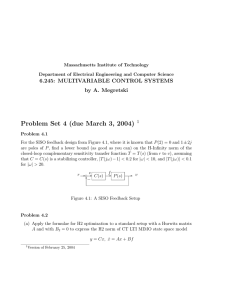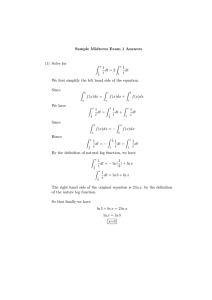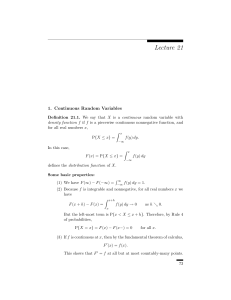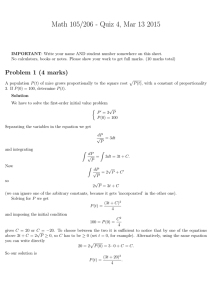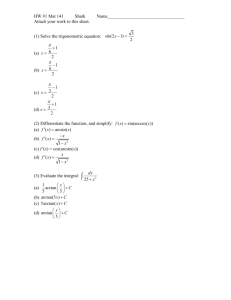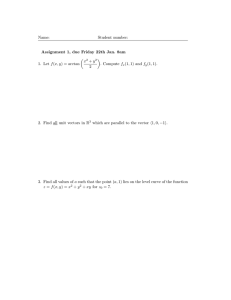Massachusetts Institute of Technology
advertisement
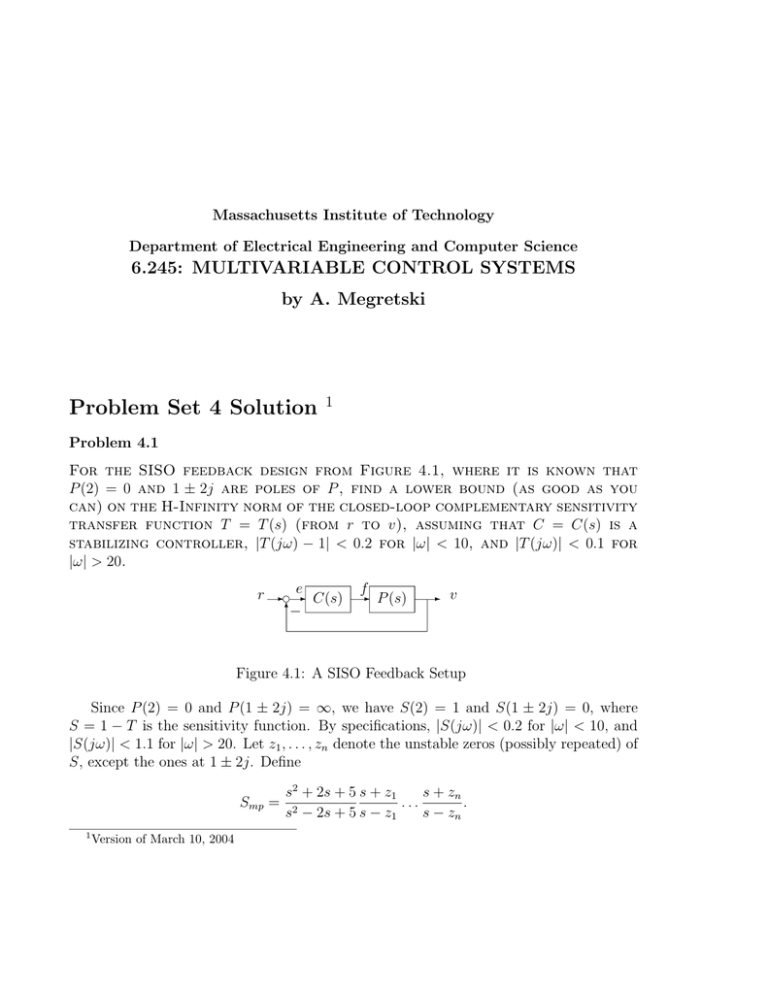
Massachusetts Institute of Technology Department of Electrical Engineering and Computer Science 6.245: MULTIVARIABLE CONTROL SYSTEMS by A. Megretski Problem Set 4 Solution 1 Problem 4.1 For the SISO feedback design from Figure 4.1, where it is known that P (2) = 0 and 1 ± 2j are poles of P , find a lower bound (as good as you can) on the H-Infinity norm of the closed-loop complementary sensitivity transfer function T = T (s) (from r to v), assuming that C = C(s) is a stabilizing controller, |T (j�) − 1| < 0.2 for |� | < 10, and |T (j�)| < 0.1 for |�| > 20. e f r � C(s) P (s) � − v Figure 4.1: A SISO Feedback Setup Since P (2) = 0 and P (1 ± 2j) = √, we have S(2) = 1 and S(1 ± 2j) = 0, where S = 1 − T is the sensitivity function. By specifications, |S(j�)| < 0.2 for |� | < 10, and |S(j�)| < 1.1 for |� | > 20. Let z1 , . . . , zn denote the unstable zeros (possibly repeated) of S, except the ones at 1 ± 2j. Define Smp = 1 Version of March 10, 2004 s + zn s2 + 2s + 5 s + z1 . . . . s2 − 2s + 5 s − z1 s − zn 2 Then Smp is stable, has no unstable zeros, and satisfies S(√) = 1. Hence log(Smp ) belongs to the class H2, and ⎡ ⎡ 2 � log |S(2j�)|d� 1 � 2 log |Smp (j�)|d� = log|Smp (2)| = . � −� 4 + �2 � 0 1 + �2 Since |Smp (j�)| = |S(j�)|, and Smp (2) = 13/5, this implies ⎡ 5 ⎡ 10 � log(0.2)d� log(≥S≥� )d� log(1.1)d� 13 log + + � 2 2 5 1+� 1 + �2 1 + �2 0 5 = arctan(5) log(0.2) + (arctan(10) − arctan(5)) log(≥S≥� ) + (�/2 − arctan(10)) log(1.1). Hence log ≥S≥� � � 2 log 13 − arctan(5) log(0.2) − (�/2 − arctan(10)) log(1.1) 5 , arctan(10) − arctan(5) i.e. ≥T ≥� � ≥S≥� − 1 � 2.8 · 1016 . Problem 4.2 (a) Apply the formulae for H2 optimization to a standard setup with a Hurwitz matrix A and with B2 = 0 to express the H2 norm of CT LTI MIMO state space model y = Cx, ẋ = Ax + Bf in terms of matrices C and P , where P = P � is the solution of the Lyapunov equation AP + P A� = −BB � . Consider the standard feedback optimization problem defined by ⎤ ⎦ ⎤ ⎦ Cx w1 . ẋ = Ax + Bw1 , z = , y = w2 , w = u w2 The optimal controller is obviously u ≤ 0, i.e. the closed loop system has same H2 norm as G(s) = C(sI − A)−1 B. 3 According to the solution to H2 feedback optimization problem, the square of opti­ mal H2 norm equals � trace(B1� Pf i B1 ) + trace(D12 Kf i Pse Kf� i D12 ), where Pf i , Pse and Kf i , Kse are the stabilizing solutions of the Riccati equations and the corresponding optimal state feedback gains in the associated abstract H2 optimization problems. In our case K = L = 0, and Pf i , Pse satisfy C � C + Pf i A + A� Pf i = 0, BB � + APse + Pse A� = 0. This immediately yields the formula ≥G≥2H2 = trace(B � Wo B), where Wo = Pf i = Q is the observability Gammian of system G, a solution of the Lyapunov equation QA + A� Q = −C � C. Noting that H2 norms of systems C(sI − A)−1 B and B � (sI − A� )−1 C � must be equal (since trace of M M � equals trace of M � M for all M ), we get the equivalent formula ≥G≥2H2 = trace(CWc C � ), where Wc = Pse = P is the controllability Gammian of system G, a solution of the Lyapunov equation AP + P A� = −BB � . (b) Use the result from (a) to obtain an explicit (with respect to a 0 , a1 , a2 ) formula for the H2 norm of system with transfer function G(s) = s3 + a2 s2 1 , + a1 s + a 0 where a0 , a1 , a2 are positive real numbers such that a1 a2 > a0 . Using the state space realization with � ⎣ � ⎣ 0 1 0 0 � � 0 1 �, B = � 0 �, C = 1 0 0 , A=� 0 −a0 −a1 −a2 1 4 and solving the Lyapunov equation AP + P A� = −BB � as a set of linear equations with respect to the components of P = P � , yields ⎣ � a2 /a0 0 −1 1 � 0 1 0 �. P = 2(a1 a2 − a0 ) −1 0 a1 Hence ≥G≥H2 = a2 . 2a0 (a1 a2 − a0 ) � (c) Use MATLAB to check numerically correctness of your analytical solution. The script is given in ps4 2.m. Problem 4.3 An undamped linear oscillator with 3 degrees of freedom is described as a SISO LTI system with control input v, “position” output q, and transfer function 1 P0 (s) = . 2 (1 + s )(4 + s2 )(16 + s2 ) The position output q is measured with delay and noise, so that the sensor output g is defined as g = 0.1f1 + q̂, where q̂ is output of an LTI system with input q and transfer function P1 (s) = 1−s . 1+s The task is to design an LTI controller which takes g and a scalar refer­ ence signal r as inputs, produces v as its output, and satisfies the follow­ ing specifications, assuming r is the output of an LTI system with input f 2 and transfer function � 2a P2 (s) = , s+a where a > 0 is a parameter, and f = [f1 ; f2 ] is a normalized white noise: (a) the closed loop system is stable; (b) the closed loop dc gain from r to q equals 1; 5 (c) the mean square value of control signal v is within 100; (d) the mean square value of tracking error e = q − r is as small as possible (within 20 percent of its minimum subject to constraints (a)-(c)). Use H2 optimization to solve the problem for a = 0.2 and a = 0.01. The MATLAB design code ps4 3.m uses SIMULINK diagram ps4 3a.mdl. Note how asymptotic tracking is forced by adding a pure integrator to the controller structure. Parameter r us used to tune the mean square control value (the smaller r, the large it is). Parameter d weights the artificial costs and noises introduces to assure non-singularity of the design setup. The Bode plot demonstrates asymptotic tracking in the closed loop system. For a = 0.01, a decent tracking error of 0.2 (20 percent of reference) can be achieved. For a = 0.2 performance is very poor at 0.78. For a = 1, the “tracking” task is essentially not approached.
